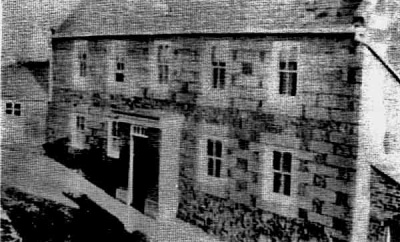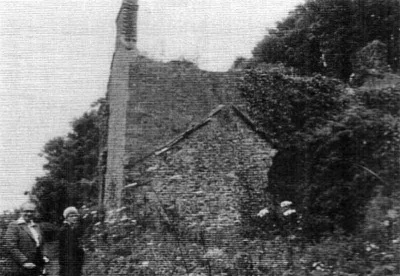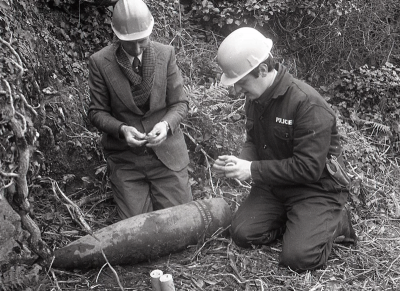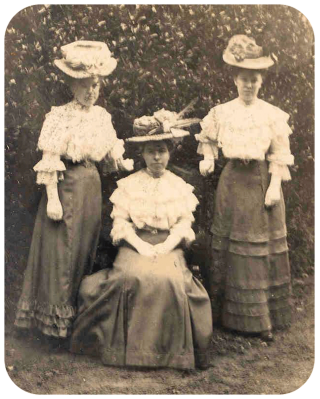Historic Environment Record entry
Ruins of late 18th century farmhouse with late 19th century house. Shown on the Richmond Map of 1795. Farmstead shown on 1934 Ordnance Survey map with principal farmhouse, range of barns to the west, and second house with sheds and pigsties attached. The area around Egypte was used by the German occupying forces as a battle training area. On 14 July 1943 the occupants of the farms in the immediate vicinity were given 24 hours to leave. The buildings were then partially demolished in order to train troops in street and house-to-house combat.
History
This history of the property has been drawn from material published by the Jersey Evening Post and a history of the property held by La Société Jersiaise, written by an unknown descendant of the Le Boutillier family.
JEP background feature
Jersey is a community scattered with reminders of the five-year period when a foreign army came ashore and took control of the island. Coastal fortifications, certain roads and an underground hospital are all reminders that between June 1940 and May 1945 Germans effected major changes to our landscape.
Egypt Farm was one of three taken over by German soldiers in 1943, some years after their owners, the Rice family, had left for England – and was used as SAS-style ‘killing houses’ to train troops in street fighting and house-to-house combat.
But the ruined structures, now overgrown with plants, could be rebuilt after politicians backed plans to rebuild at the site.
But as the newspaper reported, there was significant opposition within the Planning Department to the application, on the basis that the property had been abandoned and any construction would represent new building rather than replacement of existing structures.
Rice family
A 1945 Evening Post report on the damage wrought by the Germans notes that Egypt Farm was home for many years for the Gibaut family. A Dr Hitchcock, who lived there at one time, constructed a ballroom in one of the outbuildings.
After Alfred Rice bought one of the farms at Egypt in 1936 the buildings at the site were renovated by Gordon Rice, his son, for use as family homes. The family evacuated to England at the start of World War Two. Gordon Rice served with the Jersey Militia and joined the 11th Royal Hampshire Regiment during the war.
On returning to the island the family found their homes in ruins. They moved to St Peter and were offered £2,000 in 1949 by the British government in compensation. But this was only about a seventh of the estimated rebuilding cost at the time. It is not known whether the money was accepted or paid.
The family moved to South Africa leaving their property untouched, although they continued to pay parish rates and the land surrounding the ruins continued to be farmed.
During the early 1970s Lower Egypt Farm, which had been rebuilt by the de la Mare family in around 1950, was sold and planning permission was later given to demolish and rebuild a new house on the same site.
The Rice family has been trying since 1984 to persuade planners to allow the rebuilding of their ruined homes, but they have been refused, and now the site falls within the Coastal National Park, which carries the strongest presumptions against development.
Gibaut family
Le Boutillier family and Egypt Farm
- "From my childhood days I was always intrigued by a hand tinted photograph of La Corbiere Lighthouse (located on the south-western tip of Jersey), which hung over the fireplace in the front room of my paternal grandparents' house at Rayleigh, Essex. Why this bleak seascape took pride of place in their home I will never know, except that it did form a permanent reminder of their Jersey background and my grandfather had been a sailor.
- "I cannot recollect when Egypt Farm itself first came to my attention but, located as it is on the north coast in the Rondin district of Trinity Parish, it has no apparent link with La Corbiere Point, which is several miles away on the diagonally opposite corner of the island. I often wondered about this unusual name for a Jersey farm, and its association with the North African country from which it apparently took its name.
- "Any medium scale map of Jersey shows that the local area is known as Egypt, so the farm appears to have inherited its name from its location. The country of Egypt is named after the nomadic tribes that once roamed the land, and under 'Egyptian' my dictionary includes a now obsolete meaning as 'gypsy' (now more commonly spelt `gipsy'). It seems probable to me that the location derived its name from this source, the area perhaps being a favourite Romany site.
- "Back in the 1960s I met a young man called Barry de la Mare. At that time Barry lived with his parents at Maison de Bas, Trinity, which they ran as a guesthouse. He told me that Maison de Bas had been built since the Second World War on the site of what had previously been known as Lower Egypt Farm and that the Egypt Farm complex had consisted of several homesteads, all of which had been demolished during the War.
- "The Germans had selected this remote cluster of buildings to use for target practice from some way off and totally demolished them with the exception of a few stark stone walls still standing among the undergrowth.
Surviving photographs
- "Some photographs of the individual buildings have survived, the earlier ones on this page having been obtained by Barry from an elderly acquaintance of his who remembered the farm from before the War. I found a later photograph among my Aunt Emily's collection, which was clearly the same location, thus confirming the authenticity of the earlier snaps.
- "The only view of the farm buildings as a group, seen nestling in the valley, comes not from a photograph, but a watercolour painting handed down through the family which is clearly signed `R Hamilton Chapman 1889'.
- "My Aunt Edith always maintained that the view down the valley showed the sea in the distance but the transition from sea to sky cannot quite be discerned in the faded picture. Later photographs of the ruins show that this was true.
- "I have visited the site several times over the years with my family and friends. It is difficult to pinpoint every building as portrayed in the painting, but the end gable still standing must be the remains of the main farmhouse. Behind this dwelling, the copse of evergreen holm oak, a native of the Mediterranean and southwest Europe, is still there and in the early spring the ground is carpeted with a mass of wild snowdrops as nature begins to take over once again.
- "I have yet to establish the date when Peter acquired Egypt Farm. Barry de La Mare told me that it was his family who owned Egypt Farm before Peter Le Boutillier, it having come into their possession around 1840. The de La Mare family then acquired Lower Egypt Farm on 27 October 1860 (it has remained in their family ever since).
- "However, Peter does not appear to have moved to Egypt at that time, which would have been a natural conclusion, although he certainly had a connection with the family, having undoubtedly married Emilie de la Mare by then. I have Peter Le Boutillier, his wife Emilie and their baby son recorded in 1861 living at Grande Augres, Trinity with Peter (aged 22) listed as 'Farmer, 6 acres; employing one boy'. This was no doubt 16-year-old Jacques Paigeon, born in France, an agricultural labourer who was resident with the family at the time.
- "This did not mention Egypt Farm, and Augres district is in the south of the parish; Egypt is in the north. In 1871 the family was recorded at Petit Augres, Trinity (I am not sure of the significance of 'Grande' and 'Petit' Augres), and by now farmer Peter was credited with 12 acres.
Peter Le Boutillier
- "The first reference connecting Peter Le Boutillier with Egypt Farm did come through Barry de la Mare, however. The following is a quote from a letter to me in 1968:
- "I have been told by my great aunt Eveline that it was Peter Le Boutillier who first cultivated the slopes adjacent to Egypt Farm. In Jersey these slopes, which are very productive, are known as `cotils’.
- "This is probably true, as I have found one Peter Le Boutillier mentioned in a Directory of Jersey dated 1874, where he is described as 'Farmer and landowner, Egypt Farm'.
- "Within ten years Peter and his family had moved on. Perhaps the slopes were not quite as productive as at first envisaged.
- "For some time I was confused by another reference to a Le Boutillier family living at Egypt Farm in the mid-1800s after Miss Adele Le Boutillier of St Helier, wrote to me with her recollections. As a child her father had taken her to Egypt Farm where she understood her grandfather James Le Boutillier had farmed.
- "I naturally assumed that he was one of our ancestors but this was not the case. I can find no relationship between these two families but, bearing in mind that Egypt Farm comprised a number of homesteads, it could be that James and his family were tenants of one of the properties during the period of the de la Mare ownership.
Canada
- "I have chosen to centre this account around Peter because, for many years, he and Egypt Farm were the earliest associations my family had with their Jersey heritage. He was also head of the family at the time when, with the exception of my grandfather, they made the decision to immigrate to Canada. Grandfather was to leave Jersey shortly afterwards, thus ending all ties with the island.
- "Peter was born on 31 December 1838, the third of four children all born in Trinity. His parents were Pierre Le Boutillier and Elizabeth (née Dorey). An elder brother, baptised Peter, had been born two years earlier but had died in infancy and, as often happened in those days of frequent infant mortality, the next born had been baptised in the same name - only this time the French version `Pierre'. Even so, he appears to have been called Peter from a very early age and throughout his life used the anglicised version even on official documents.
- "Peter had an elder sister, Elizabeth, born 19 July 1833. I know that she was still living with the family in 1851 and will refer to her again later. A younger brother, John, was born 15 December 1846 and although he was recorded in 1861 as a scholar, this is the only reference I have regarding him.
- "I have not as yet researched the marriage between Peter Le Boutillier and Emilie de la Mare but this probably took place in the late 1850s with their first child Peter, the baby son mentioned earlier, being born on 6 November 1860. Emilie, daughter of Philippe de la Mare, had been born around January 1838 in St Martin. [1]
- "On a visit to Jersey in June 2001 I found that Philippe Le Boutillier and Rachel Fauvel did have children, born in St Saviour. A son Philippe was baptised on 27 October 1773 with a Philippe Ahier and Marie Maurant being named as godparents. A daughter Anne was baptised on 2 July 1777 with Pierre Le Boutillier and Anne Lair his wife (her uncle and aunt) as godparents.
Family tree
Jerripedia editor Mike Bisson cannot resist the temptation to use the website's records and other sources to find out more about a postcard sent over a century before it was added to the site, after being put up for sale on an online auction site. The first part of this one was easy - the 1901 census reveals that the recipient of the card was Clementina Gibaut, then aged 15, and that she lived at Egypt Farm with her parents, farmer John (1854- ) and his wife, also Clementina (1861- ), her elder brother John, younger sisters Edith and Irene, and five more brothers, Edwin, Herbert, Raymond, Lewis and Harold. Jerripedia's family records database reveals that John was John Francis Abraham Gibaut, son of Philippe, and that he married Clementina Elizabeth Huelin, daughter of James and Mary Ann, nee Renouf, at Trinity in 1881. She was recorded in the wedding entry as Clementine, but in all other records as Clementina. The identity of the sender of the card is less certain. Janie could have been one of several Jane Le Riches, but Mike thinks it most likely that she was Jane Elvina, the daughter of Abraham Nicolas Le Riche and Jane Esther, nee Nicolle, born in Trinity in 1885
Notes and references
- ↑ Emilie Susanne de la Mare, daughter of Philippe and Elizabeth Le Riche, was born in 1833 and baptised on Christmas Day









